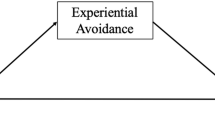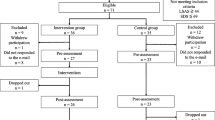Abstract
We examined specific mindfulness skills (observing, describing, acting with awareness, accepting without judgment, as measured by the Kentucky Inventory of Mindfulness Skills, in terms of anxiety-related cognitive processes among adult daily smokers (n = 90; 43 females; Mage = 26.6 years, SD = 11.8). Partially consistent with hypotheses, describing and accepting without judgment were each shown to significantly predict perceived control over anxiety-related events. The observed significant effects were evident above and beyond the variance accounted for by gender, smoking rate, and negative affectivity. Although observing also was shown to significantly predict agoraphobic cognition, it was in the opposite direction as was theoretically expected. No evidence of incremental validity for mindfulness skills was evident for anxiety sensitivity. These data highlight the potential explanatory relevance of only specific mindfulness skills in terms of only certain anxiety-based cognitive processes among adult daily smokers.
Similar content being viewed by others
References
Adele, M. H., & Feldman, G. (2004). Clarifying the construct of mindfulness in the context of emotion regulation and the process of change in therapy. Clinical Psychology: Science and Practice, 11, 255–262. doi:10.1093/clipsy.bph080.
Baer, R. A., Smith, T. G., & Allen, K. B. (2004). Assessment of mindfulness by self-report. Assessment, 11, 191–206. doi:10.1177/1073191104268029.
Baer, R. A., Smith, G. T., Hopkins, J., Krietemeyer, J., & Toney, L. (2006). Using self-report assessment methods to explore facets of mindfulness. Assessment, 13, 27–45. doi:10.1177/1073191105283504.
Baer, R. A., Smith, G. T., Lykins, E., Button, D., Krietemeyer, J., Sauer, S., et al. (2008). Construct validity of the Five Facet Mindfulness Questionnaire in meditating and nonmeditating samples. Assessment, 15, 329–342. doi:10.1177/1073191107313003.
Baum, C., Kuyken, W., Bohus, M., Heidenreich, T., Michalak, J., & Steil, R. (2010). The psychometric properties of the Kentucky Inventory of Mindfulness Skills in clinical populations. Assessment, 17, 220–229. doi:10.1177/1073191109356525.
Bishop, S. R., Lau, M., Shapiro, S., Carlson, L., Anderson, N. D., Carmody, J., et al. (2004). Mindfulness: A proposed operational definition. Clinical Psychology: Science and Practice, 11, 230–241. doi:10.1093/clipsy.bph077.
Breslau, N., & Klein, D. F. (1999). Smoking and panic attacks: An epidemiological investigation. Archives of General Psychiatry, 56, 1141–1147. doi:10.1001/archpsyc.56.12.1141.
Brown, K. W., & Ryan, R. M. (2003). The benefits of being present: Mindfulness and its role in psychological well-being. Journal of Personality and Social Psychology, 84, 822–848. doi:10.1037/0022-3514.84.4.822.
Brown, R. A., Kahler, C. W., Zvolensky, M. J., Lejuez, C. W., & Ramsey, S. E. (2001). Anxiety sensitivity: Relationship to negative affect smoking and smoking cessation in smokers with past major depressive disorder. Addictive Behaviors, 26, 887–899. doi:10.1016/S0306-4603(01)00241-6.
Brown, R. A., Lejuez, C. W., Kahler, C. W., & Strong, D. (2002). Distress tolerance and duration of past smoking cessation attempts. Journal of Abnormal Psychology, 111, 180–185. doi:10.1037/0021-843X.111.1.180.
Brown, T. A., White, K. S., Forsyth, J. P., & Barlow, D. H. (2004). The structure of perceived emotional control: Psychometric properties of a revised Anxiety Control Questionnaire. Behavior Therapy, 35, 75–99. doi:10.1016/S0005-7894(04)80005-4.
Center for Disease Control and Prevention. (2008). Targeting tobacco use: The nation's leading cause of preventable death 2008. http://www.cdc.gov/nccdphp/publications/aag/pdf/osh.pdf. Accessed 11 Feb 2011.
Chambless, D. L., Caputo, G. C., Bright, P., & Gallagher, R. (1984). Assessment of fear of fear in agoraphobics: The body sensations questionnaire and the agoraphobic cognitions questionnaire. Journal of Consulting and Clinical Psychology, 52, 1090–1097. doi:10.1037/0022-006X.52.6.1090.
Conte, H. R., Ratto, R., & Karasu, T. (1996). The psychological mindedness scale: Factor structure and relationship to outcome of psychotherapy. The Journal of Psychotherapy Practice and Research, 5, 250–259.
Dekeyser, M., Raes, F., Leijssen, M., Leysen, S., & Dewulf, D. (2008). Mindfulness skills and interpersonal behaviour. Personality and Individual Differences, 44, 1235–1245. doi:10.1016/j.paid.2007.11.018.
Fagerström, K.-O. (1978). Measuring degree of physical dependence to tobacco smoking with reference to individualization of treatment. Addictive Behaviors, 3, 235–241.
Feldner, M. T., Babson, K. A., & Zvolensky, M. J. (2007). Smoking, traumatic event exposure, and post-traumatic stress: A critical review of the empirical literature. Clinical Psychology Review, 27, 14–45. doi:10.1016/j.addbeh.2006.03.032.
First, M. B., Spitzer, R. L., Gibbon, M., & Williams, J. B. W. (1995). Structured Clinical Interview for DSM-IV Axis I Disorders—Non-Patient Edition. New York: New York State Psychiatric Institute.
Forsyth, J. P., Parker, J. D., & Finlay, C. G. (2003). Anxiety sensitivity, controllability, and experiential avoidance and their relation to drug of choice and addiction severity in a residential sample of substance-abusing veterans. Addictive Behaviors, 28, 851–870.
Gonzalez, A., Vujanovic, A. A., Johnson, K. A., Leyro, T. M., & Zvolensky, M. J. (2009). The role of mindful attention in regard to the relation between negative affect reduction outcome expectancies and emotional vulnerability among adult daily smokers. Cognitive Therapy and Research, 33, 645–656. doi:10.1007/s10608-009-9246-x.
Gregor, K. L., & Zvolensky, M. J. (2008). Anxiety sensitivity and perceived control over anxiety-related events: Evaluating the singular and interactive effects in the prediction of anxious and fearful responding to bodily sensations. Behaviour Research and Therapy, 46, 1017–1025. doi:10.1016/j.brat.2008.06.003.
Gregor, K. L., Zvolensky, M. J., McLeish, A. C., Bernstein, A., & Morisette, S. (2008). Anxiety sensitivity and perceived control over anxiety-related events: Associations with smoking outcome expectancies and perceived cessation barriers among daily smokers. Nicotine & Tobacco Research, 10, 627–635. doi:10.1080/14622200801978706.
Heatherton, T. F., Kozlowski, L. T., Frecker, R. C., & Fagerström, K.-O. (1991). The Fagerström test for nicotine dependence: A revision of the Fagerström Tolerance Questionnaire. British Journal of Addiction, 86, 1119–1127.
Isensee, B., Wittchen, H.-U., Stein, M. B., Hofler, M., & Lieb, R. (2003). Smoking increases the risk of panic: Findings from a prospective community study. Archives of General Psychiatry, 60, 692–700. doi:10.1001/archpsyc.60.7.692.
Marshall, E. C., Johnson, K. A., Bergman, J., Gibson, L. E., & Zvolensky, M. J. (2009). Anxiety sensitivity and panic reactivity to bodily sensations: Relation to quit-date (acute) nicotine withdrawal symptom severity among daily smokers making a self-guided quit attempt. Experimental and Clinical Psychopharmacology, 17, 356–364. doi:10.1037/a0016883.
McKee, L., Zvolensky, M. J., Solomon, S. E., Bernstein, A., & Leen-Feldner, E. (2007). Emotional-vulnerability and mindfulness: A preliminary test of associations among negative affectivity, anxiety sensitivity, and mindfulness skills. Cognitive Behaviour Therapy, 36, 91–100. doi:10.1080/16506070601119314.
McLeish, A. C., Zvolensky, M. J., & Bucossi, M. M. (2007). Interaction between smoking rate and anxiety sensitivity: Relation to anticipatory anxiety and panic-relevant avoidance among daily smokers. Journal of Anxiety Disorders, 21, 849–859. doi:10.1016/j.janxdis.2006.11.003.
Morissette, S. B., Tull, M. T., Gulliver, S. B., Kamholz, B. W., & Zimering, R. T. (2007). Anxiety, anxiety disorders, tobacco use, and nicotine: A critical review of interrelationships. Psychological Bulletin, 133, 245–272. doi:10.1037/0033-2909.133.2.245.
Novak, A., Burgess, E. S., Clark, N., Zvolensky, M. J., & Brown, R. A. (2003). Anxiety sensitivity, self-reported motives for alcohol and nicotine use, and level of consumption. Journal of Anxiety Disorders, 17, 165–180. doi:10.1016/S0887-6185(02)00175-5.
Orsillo, S. M., & Roemer, L. (2005). Acceptance and mindfulness-based approaches to anxiety: Conceptualization and treatment. New York: Springer.
Patton, G. C., Carlin, J. B., Coffey, C., Wolfe, R., Hibbert, M., & Bowes, G. (1998). Depression, anxiety, and smoking initiation: A prospective study over 3 years. American Journal of Public Health, 88, 1518–1522. doi:10.2105/AJPH.88.10.1518.
Payne, T. J., Smith, P. O., McCracken, L. M., McSherry, W. C., & Antony, M. M. (1995). Assessing nicotine dependence: A comparison of the Fagerström Tolerance Questionnaire (FTQ) with the Fagerström Test for Nicotine Dependence (FTND) in a clinical sample. Addictive Behaviors, 19, 307–317. doi:10.1016/0306-4603(94)90032-9.
Piper, M. E., Smith, S. S., Schlam, T. R., Fleming, M. F., Bittrich, A. A., Brown, J. L., et al. (2010). Psychiatric disorders in smokers seeking treatment for tobacco dependence: Relations with tobacco dependence and cessation. Journal of Consulting and Clinical Psychology, 78, 13–23. doi:10.1037/a0018065.
Pomerleau, C. S., Majchrzak, M. J., & Pomerleau, O. F. (1989). Nicotine dependence and the Fagerstrom Tolerance Questionnaire: A brief review. Journal of Substance Abuse, 1, 471–477.
Pomerleau, C. S., Carton, S. M., Lutzke, M. L., Flesland, K. A., & Pomerleau, O. F. (1994). Reliability of the Fagerstrom Tolerance Questionnaire and the Fagerstrom Test for Nicotine Dependence. Addictive Behaviors, 19, 33–39. doi:10.1016/0306-4603(94)90049-3.
Rapee, R. M., Craske, M. G., Brown, T. A., & Barlow, D. H. (1996). Measurement of perceived control over anxiety-related events. Behavior Therapy, 27, 279–293. doi:10.1016/S0005-7894(96)80018-9.
Reiss, S., Peterson, R. A., Gursky, D. M., & McNally, R. J. (1986). Anxiety sensitivity, anxiety frequency and the prediction of fearfulness. Behaviour Research and Therapy, 24, 1–8. doi:10.1016/0005-7967(86)90143-9.
Rodriguez, B. F., Bruce, S. E., Pagano, M. E., Spencer, M. A., & Keller, M. B. (2004). Factor structure and stability of the Anxiety Sensitivity Index in a longitudinal study of anxiety disorder patients. Behaviour Research and Therapy, 42, 79–91. doi:10.1016/S0005-7967(03)00074-3.
Schneider, W., & Shiffrin, R. M. (1977). Controlled and automatic human information processing: I. Detection, search, and attention. Psychological Review, 84, 1–66. doi:10.1037/0033-295X.84.1.1.
State of Vermont Department of Health. (2007). 2007 Vermont Population Estimates. http://healthvermont.gov/research/documents/RACENOTE08.pdf. Accessed 11 Feb 2011.
Vidrine, J. I., Businelle, M. S., Cinciripini, P., Li, Y., Marcus, M. T., Waters, A. J., et al. (2009). Associations of mindfulness with nicotine dependence, withdrawal, and agency. Substance Abuse, 30, 318–327. doi:10.1080/08897070903252973.
Vujanovic, A. A., Youngwirth, N. E., Johnson, K. A., & Zvolensky, M. J. (2009). Mindfulness-based acceptance and posttraumatic stress symptoms among trauma-exposed adults without axis I psychopathology. Journal of Anxiety Disorders, 23, 297–303. doi:10.1016/j.janxdis.2008.08.005.
Vujanovic, A. A., Bonn-Miller, M. O., Bernstein, A., McKee, L. G., & Zvolensky, M. J. (2010). Incremental validity of mindfulness skills in relation to emotional dysregulation among a young adult community sample. Cognitive Behaviour Therapy. doi:10.1080/16506070903441630.
Watson, D. (2000). Mood and temperament. New York: Guilford Press.
Watson, D., Clark, L. A., & Tellegen, A. (1988). Development and validation of brief measures of positive and negative affect: The PANAS scales. Journal of Personality and Social Psychology, 54, 1063–1070. doi:10.1037/0022-3514.54.6.1063.
Ziedonis, D., Hitsman, B., Beckham, J. C., Zvolensky, M. J., Adler, L. E., Audrain-McGovern, J., et al. (2008). Tobacco use and cessation in psychiatric disorders: National Institute of Mental Health report. Nicotine and Tobacco Research, 10, 1691–1715. doi:10.1080/14622200802443569.
Zvolensky, M. J., & Bernstein, A. (2005). Cigarette smoking and panic psychopathology. Current Directions in Psychological Science, 14, 301–305. doi:10.1111/j.0963-7214.2005.00386.x.
Zvolensky, M. J., Schmidt, N. B., & Stewart, S. H. (2003). Panic disorder and smoking. Clinical Psychology: Science and Practice, 10, 29–51. doi:10.1093/clipsy/10.1.29.
Zvolensky, M. J., Feldner, M. T., Leen-Feldner, E. W., Gibson, L. E., Abrams, K., & Gregor, K. (2005a). Acute nicotine withdrawal symptoms and anxious responding to bodily sensations: A test of incremental predictive validity among young adult smokers. Behaviour Research and Therapy, 43, 1683–1700. doi:10.1016/j.brat.2004.10.010.
Zvolensky, M. J., Feldner, M. T., Leen-Feldner, E. W., & McLeish, A. C. (2005b). Smoking and panic attacks, panic disorder, and agoraphobia: A review of the empirical literature. Clinical Psychology Review, 25, 761–789. doi:10.1016/j.cpr.2005.05.001.
Zvolensky, M. J., Bonn-Miller, M. O., Feldner, M. T., Leen-Feldner, E., McLeish, A. C., & Gregor, K. (2006). Anxiety sensitivity: Concurrent association with negative affect smoking motives and abstinence self-confidence among young adult smokers. Addictive Behaviors, 31, 429–439. doi:10.1016/j.addbeh.2005.05.027.
Zvolensky, M. J., Gibson, L. E., Vujanovic, A. A., Gregor, K., Bernstein, A., Kahler, C., et al. (2008). Impact of posttraumatic stress disorder on early smoking lapse and relapse during a self-guided quit attempt among community- recruited daily smokers. Nicotine and Tobacco Research, 10, 1415–1427. doi:10.1080/14622200802238951.
Zvolensky, M. J., Stewart, S. H., Vujanovic, A. A., Gavric, D., & Steeves, D. (2009). Anxiety sensitivity and anxiety and depressive symptoms in the prediction of early smoking lapse and relapse during smoking cessation treatment. Nicotine and Tobacco Research, 11, 323–331. doi:10.1093/ntr/ntn03.
Author information
Authors and Affiliations
Corresponding author
Rights and permissions
About this article
Cite this article
Luberto, C.M., McLeish, A.C., Zvolensky, M.J. et al. Mindfulness Skills and Anxiety-Related Cognitive Processes Among Young Adult Daily Smokers: A Pilot Test. Mindfulness 2, 129–136 (2011). https://doi.org/10.1007/s12671-011-0052-7
Published:
Issue Date:
DOI: https://doi.org/10.1007/s12671-011-0052-7




